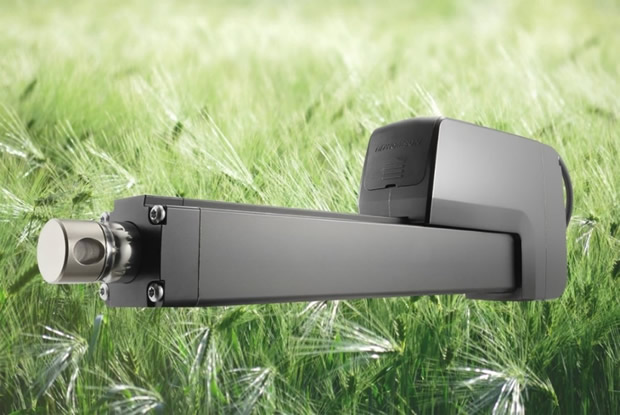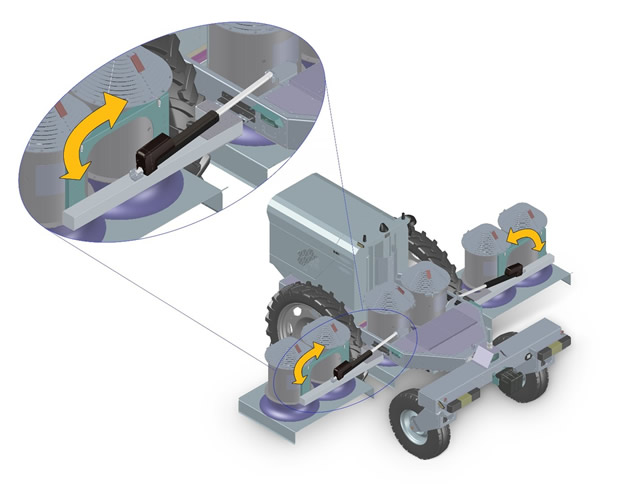Agrobot is actively developing other iterations of the Bug Vacuum, including even larger footprints. As the company extends its solutions to new axes of motion, Thomson engineers and BIBUS Spain, S.L., will be working with them to meet any actuator challenges that emerge.
Autonomous farm robots optimize pest control with electric linear actuators
Case Study from | Thomson Industries
Strawberry fields are subject to a significant, ongoing threat from insects, especially lygus bugs, which feed on the sap of strawberry plants. Left unchecked, lygus bugs damage fruit by puncturing individual seeds; this, in turn, stops the development of the berry in the area surrounding the feeding site. Agrobot, a Spain-based leader in the rapidly growing field of agricultural robots and smart farming machinery, has developed a unique pest control solution, which incorporates Thomson electromechanical actuators, to vacuum the lygus without harming the strawberries.

Figure 1: The Bug Vacuum is navigating autonomously around the strawberry fields while performing efficient, accurate and cost-effective lygus pest control.
Limitations of existing vacuum systems
More than half of all strawberry farmers in California control lygus infestations with vacuum fans mounted on tractors. The driver guides the tractor through the rows and over the bushes and operates powerful vacuum fans that suck the lygus away from the beds. The closer the vacuum gets to the plants without touching them, the greater the suction and the more effective the removal of the pests. Since the plants vary in height, operators rely on their judgment to adjust the proximity of the fan, raising and lowering it.
“Using traditional vacuum fans attached to tractors is a noisy, windy and dusty job. We had been working with a farmer on automating his strawberry harvesting operations, and he asked us to automate bug removal as well,” said Juan Bravo, CEO at Agrobot.
A mobile bug vacuum
Bravo and his team developed the Bug Vacuum, a powerful fan transported as part of a mobile robot. (Figure 1) The fan is like those on traditional pest control tractors but equipped with laser light detection and ranging (LIDAR) sensors that signal an onboard actuator to raise or lower the fans according to the contours of the beds. The distances are set in advance but can be configured as well.
“To compare the performance of the human- and robot-driven systems, we covered both mobile robots with nets to see how many bugs each captured. The netting in the automated vehicle captured significantly more lygus than the human-operated vehicle,” said Bravo.

Figure 2: The Bug Vacuum has a double-fan vacuum system to ensure a uniform airflow over the whole bed width. Using Electrak HD actuators, the precise control of the fan height achieves optimal vacuum pressure and maximizes bug removal.
To set the robot in motion with the Bug Vacuum, a farmer takes it to a kickoff point and selects its ‘Automatic Mode.’ From then on, the robot’s LIDAR sensors detect bed furrows as guidance references within each row. Once furrows end, the navigation controller decides the next move, moving to the next row ahead, making a U-turn to move down an adjacent furrow or finishing the routine.
One version of the Bug Vacuum uses a two-fan system to ensure a uniform airflow across the width of the bed. As the vehicle moves through the furrows, vacuum fans operate at wind speeds up to 40 miles per hour to create the vacuum that pulls the bugs upwards and away from the plants. (Figure 2)
Finding the right actuator
Because maintaining the optimal distance between the fan input and the strawberry bushes is so critical to achieving maximum performance, Bravo evaluated several electric actuators before settling on a model from Thomson Industries.
“One actuator that we tried could not handle the torque we needed. Another didn’t have end control, so it would keep moving toward the plant. We also needed actuators that could withstand the warm, moist ocean air in which strawberries thrive. Only Thomson actuators had everything we needed to control the accuracy and precision of our system,” said Bravo.

Figure 3: Safe, Clean and Green: Thomson Electrak HD electric actuators offer a full suite of integrated control options such as speed control, position and force feedback and CAN bus communication, with clean, maintenance-free and energy-efficient operation.
Working closely with Thomson engineers and their distribution partner and automation expert BIBUS Spain, S.L., Bravo selected Electrak® HD electric linear actuators to be bolted to the fan housing to control the distance from the plants. (Figure 3) The HD is a compact unit that can lift loads of up to 3,525 lbs (1.6 tons), which is more than enough to handle the weight of the fan. Plus, the HD’s ingress protection rating of IP69K static and IP66 dynamic addresses any environmental challenges.
The onboard electronics and built-in SAE J1939 CAN bus communications met Agrobot’s need for position and accuracy control, enabling smooth movement within the precise range of motion. After the navigation control system receives position coordinates from the LIDAR sensors, it processes that data into movement instructions for the actuators. The actuators respond in real-time by moving their rods back and forth to maintain fan position at the optimal distance from the bushes. Communications among the LIDAR sensors, the navigation control unit and actuators all take place across the CAN bus network.
“The actuators enable us to define the height of the fans and provide feedback on the current position so we can define a different position as needed. If the position is off by just a few centimeters, too high or too low, it will reduce efficiency or damage the plants,” said Bravo.
Spreading its wings
The initial Bug Vacuum model covers one row at a time, but a newly introduced version uses six fans to extend coverage to three rows, adjusting the width to match the size of the rows. This enhancement has significantly increased yield. To make the wider version easy to transport, two additional Electrak HD actuators are used to fold the extensions, resembling wings, making it easier to maneuver through narrow spaces.

Figure 4: Extended Bug Vacuum with multiple fans and wings that are extended and retracted by two additional Thomson Electrak HD actuators.
The same robust control and environmental resistance characteristics that make the Electrak HD actuators ideal for raising and lowering the fans also make them suitable for folding the wings. (Figure 4)
Ongoing struggle
Agrobot is actively developing other iterations of the Bug Vacuum, including even larger footprints. As the company extends its solutions to new axes of motion, Thomson engineers and BIBUS Spain, S.L., will be working with them to meet any actuator challenges that emerge. And as for the lygus, combating them will be an eternal struggle as they continue visiting the strawberry fields.
The content & opinions in this article are the author’s and do not necessarily represent the views of AgriTechTomorrow
Comments (0)
This post does not have any comments. Be the first to leave a comment below.
Featured Product

